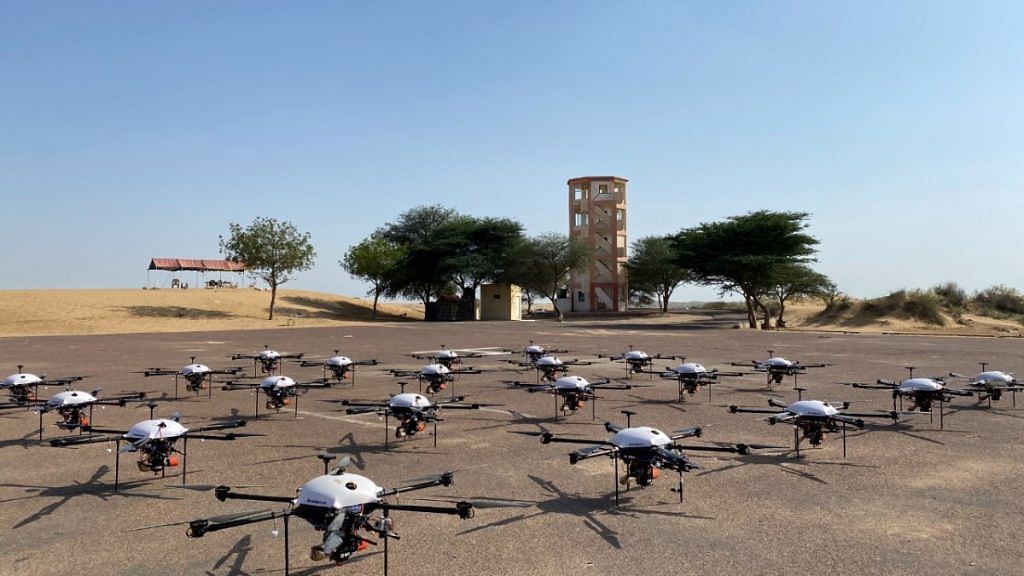Bengaluru: In a boost to its offensive capability, the Army has started taking delivery of its first heterogeneous swarm Unmanned Aerial Vehicle (UAV) system for use on the battlefield, ThePrint has learnt.
This delivery may possibly be the world’s first operational high density swarming UAS (Unmanned Aerial System) induction for military applications, especially given that most swarm drone research is yet to be operationalised across the world.
Supplied by an Indian start up – Bengaluru based NewSpace Research & Technologies – the swarm of 100 drones is capable of hitting targets at least 50 kms away into enemy territory.
Defence sources told ThePrint that the delivery has just begun and comes at a time when the country’s military air show Aero India began here.
The swarming systems were ordered under the emergency procurement (EP) and show that India has taken a global lead with induction of a cutting edge ‘Made in India’ technology which is at par, if not ahead, of its peers across the world, sources said.
They added that this is a part of the government’s Aatmanirbhar effort to indigenise critical and disruptive military technologies.
Sources explained that these drones are capable of carrying bombs of a particular weight and can home into a target, like moving armoured columns, artillery positions, and infantry bunkers and attack.
They added that swarm drones are the solution for a closely contested airspace where individual drones can be taken down.
The IAF will also induct operational swarming UAS in the near future.
ThePrint reached out to Col Ramit Arora (Retd), Business Development head at NewSpace Research. He confirmed that the deliveries to users against contracts placed have started recently, but refused to share any further detail.
Defence sources confirmed that the drones delivered by NewSpace, and a follow-on homogeneous swarm drone delivery from Raphe Mphibr in days ahead, will be inducted into the mechanised forces where they will be used for surveillance and attack missions.
Also read: HAL unveils design for new supersonic trainer, can aid IAF in modern combat training
How swarm drones work
A swarming system consists of a group of UAVs which cooperate with each other using advanced autonomy, computing, communication and AI protocols to execute various mission objectives with minimal human intervention.
The UAVs exhibit self-organising behaviour, collision avoidance between the UAVs and obstacle avoidance with terrain.
In a true swarm, there is no true leader and follower, with all members in a swarm having their own ‘mind’ to undertake collective decision-making, adaptive formation flying, and self-healing within the swarm, as Sameer Joshi, the founder of NewSpace, had written for ThePrint earlier.
The benefit of such a swarm is that if one drone drops out or a few crash due to enemy counter measures, the group can rearrange or self-heal itself to continue undertaking the mission till the last UAV in air.
“Massed attacks are very difficult to counter using conventional defences and can overwhelm the defenders to a great extent. This has only been highlighted in the high density drone attacks on Russian forces in Ukraine and on the Saudi oilfields. Swarm UAVs thus offer a highly asymmetric value of return and very significantly, drones working together and aiming for target saturation through numbers not only have a greater chance to achieve mission success, but also impose a high cost penalty on the air defence elements,” a source explained.
Countries such as the United States, United Kingdom, Turkey, Russia, Israel and China are actively pursuing swarm drones programmes.
While new technologies — AI and edge computing in particular — will drive drone swarms, sources said the key element is the swarming software.
It is this facet of swarming that makes the development of swarms difficult and few nations have been able to demonstrate missions exhibiting de-centralised swarming algorithms, India being one of them, sources said.
Genesis of India’s swarm drone programme
The genesis of India’s swarm drones is in the Indian Air Force’s Mehar Baba swarm drone competition of 2018.
The idea then was to encourage start-ups to work on swarm UAVs, both for humanitarian and military missions.
NewSpace Research & Technologies won the award for best ‘swarming architecture’ and is understood to have performed well on all parameters in this competition. The ‘communication architecture’ award went to a Delhi Technology University team in a tie-up with Adani Defence, and the ‘drone architecture’ award went to Dhaksha Unmanned Systems.
In the Army, it is the Army Design Bureau that is responsible for induction of futuristic technologies and put in motion some of the most advanced programmes to be delivered in swarming domains.
It was in January 2021 that the Army showcased for the first time swarm drones’ offensive capability by carrying out a simulated Kamikaze attack on targets, including enemy tanks, fuel depots, terror hideout and radar positions, among others, at the Army Day Parade held in Delhi Cantonment.
While what the Army showcased was a swarm of 75 drones, including mother UAVs that release smaller systems, the plan is to eventually have swarm capability of 1,000 drones, as reported by thePrint earlier.
(Edited by Smriti Sinha)
Also read: China has spy balloons, India has aerostats. But IAF’s had mixed results from 16-yr-old project
